Positive Leaders and Emotional Laborers
VerifiedAdded on 2023/04/23
|11
|3204
|243
AI Summary
This document explores the impact of positive leadership on emotional laborers and the strategies used by positive leaders to enhance the productivity and wellbeing of employees. It discusses the character traits of positive leaders, the psychological capital of emotional laborers, and the role of employee engagement in their skill development. The document also highlights the impact of employee engagement on the productivity and wellbeing of emotional laborers.
Contribute Materials
Your contribution can guide someone’s learning journey. Share your
documents today.
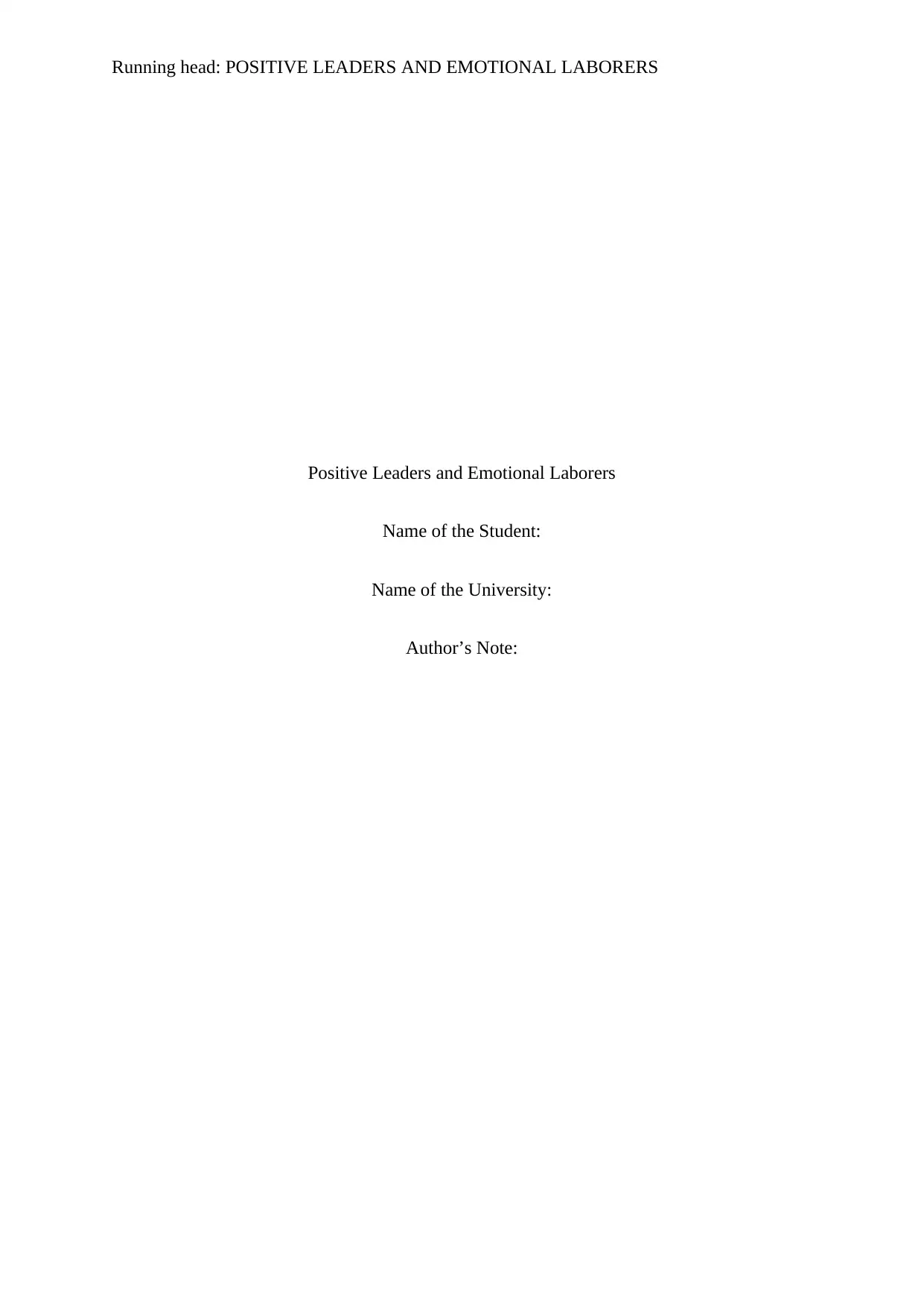
Running head: POSITIVE LEADERS AND EMOTIONAL LABORERS
Positive Leaders and Emotional Laborers
Name of the Student:
Name of the University:
Author’s Note:
Positive Leaders and Emotional Laborers
Name of the Student:
Name of the University:
Author’s Note:
Secure Best Marks with AI Grader
Need help grading? Try our AI Grader for instant feedback on your assignments.

1POSITIVE LEADERS AND EMOTIONAL LABORERS
Slide 1: Introduction
As opined by Macdonald, Burke and Stewart (2017), the leaders within the spectrum
of the contemporary organizations are increasingly playing an important role and as a matter
of fact they have become an integral part of the organizations itself. Murphy and Louis
(2018) are of the viewpoint that the contemporary leaders are required to perform not only
the job roles of the leaders but at the same time they are imbued with the responsibilities of
the managers as well. In this capacity, they are increasingly seen as the stewards of the
business organizations and the fortunes of the organizations depend greatly on the
effectiveness with which they are being able to dispense their job roles (Randel et al. 2018).
In this regard, it needs to be said that they are no longer entrusted with the job roles of
leading and motivating the subordinates but at the same time they need to offer mentoring,
coaching, participate in performance management, create effective job designs and other
similar kinds of job roles within the framework of the organizations (Wagner 2016). Thus, it
can be said that the leaders have emerged as an indispensible part of the contemporary
organizations.
Slide 2: Positive Leader
According to Shirey (2017), positive leadership is generally defined as the kind of
leadership which believes in bring together for the attainment of a common purpose or goal
or objective. More importantly, Nel, Stander and Latif (2015) have articulated the viewpoint
that the positive leaders are required to help the followers to set various kinds of milestones
for the attainment of the overall goals or the objectives outlined by the followers.
Furthermore, it is seen that the individuals taking the help of this framework of leadership are
required to take into effective consideration the entities of ethics and morals and establish
effective relationship with the subordinates, which will be based on these values (Gordon
Slide 1: Introduction
As opined by Macdonald, Burke and Stewart (2017), the leaders within the spectrum
of the contemporary organizations are increasingly playing an important role and as a matter
of fact they have become an integral part of the organizations itself. Murphy and Louis
(2018) are of the viewpoint that the contemporary leaders are required to perform not only
the job roles of the leaders but at the same time they are imbued with the responsibilities of
the managers as well. In this capacity, they are increasingly seen as the stewards of the
business organizations and the fortunes of the organizations depend greatly on the
effectiveness with which they are being able to dispense their job roles (Randel et al. 2018).
In this regard, it needs to be said that they are no longer entrusted with the job roles of
leading and motivating the subordinates but at the same time they need to offer mentoring,
coaching, participate in performance management, create effective job designs and other
similar kinds of job roles within the framework of the organizations (Wagner 2016). Thus, it
can be said that the leaders have emerged as an indispensible part of the contemporary
organizations.
Slide 2: Positive Leader
According to Shirey (2017), positive leadership is generally defined as the kind of
leadership which believes in bring together for the attainment of a common purpose or goal
or objective. More importantly, Nel, Stander and Latif (2015) have articulated the viewpoint
that the positive leaders are required to help the followers to set various kinds of milestones
for the attainment of the overall goals or the objectives outlined by the followers.
Furthermore, it is seen that the individuals taking the help of this framework of leadership are
required to take into effective consideration the entities of ethics and morals and establish
effective relationship with the subordinates, which will be based on these values (Gordon
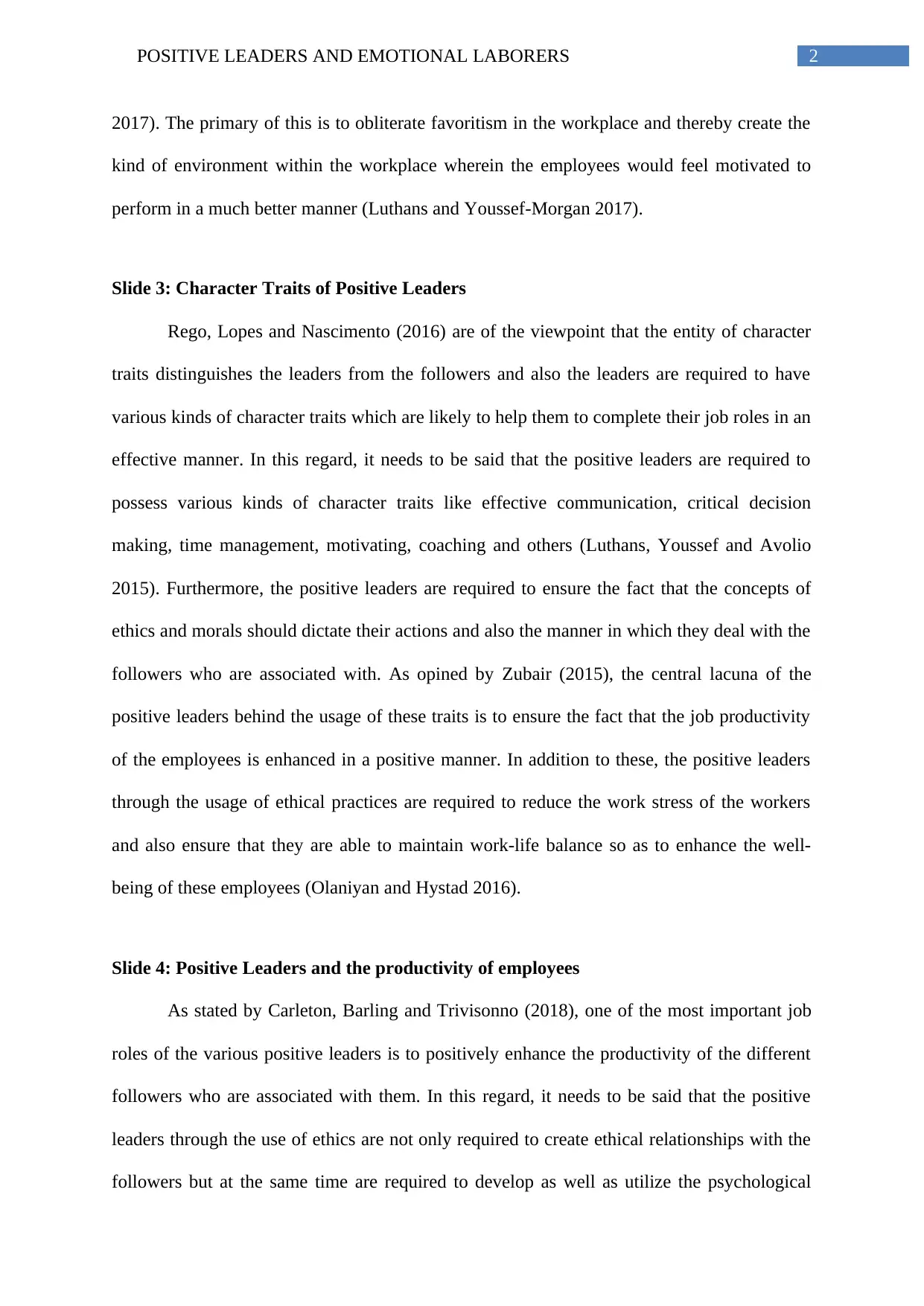
2POSITIVE LEADERS AND EMOTIONAL LABORERS
2017). The primary of this is to obliterate favoritism in the workplace and thereby create the
kind of environment within the workplace wherein the employees would feel motivated to
perform in a much better manner (Luthans and Youssef-Morgan 2017).
Slide 3: Character Traits of Positive Leaders
Rego, Lopes and Nascimento (2016) are of the viewpoint that the entity of character
traits distinguishes the leaders from the followers and also the leaders are required to have
various kinds of character traits which are likely to help them to complete their job roles in an
effective manner. In this regard, it needs to be said that the positive leaders are required to
possess various kinds of character traits like effective communication, critical decision
making, time management, motivating, coaching and others (Luthans, Youssef and Avolio
2015). Furthermore, the positive leaders are required to ensure the fact that the concepts of
ethics and morals should dictate their actions and also the manner in which they deal with the
followers who are associated with. As opined by Zubair (2015), the central lacuna of the
positive leaders behind the usage of these traits is to ensure the fact that the job productivity
of the employees is enhanced in a positive manner. In addition to these, the positive leaders
through the usage of ethical practices are required to reduce the work stress of the workers
and also ensure that they are able to maintain work-life balance so as to enhance the well-
being of these employees (Olaniyan and Hystad 2016).
Slide 4: Positive Leaders and the productivity of employees
As stated by Carleton, Barling and Trivisonno (2018), one of the most important job
roles of the various positive leaders is to positively enhance the productivity of the different
followers who are associated with them. In this regard, it needs to be said that the positive
leaders through the use of ethics are not only required to create ethical relationships with the
followers but at the same time are required to develop as well as utilize the psychological
2017). The primary of this is to obliterate favoritism in the workplace and thereby create the
kind of environment within the workplace wherein the employees would feel motivated to
perform in a much better manner (Luthans and Youssef-Morgan 2017).
Slide 3: Character Traits of Positive Leaders
Rego, Lopes and Nascimento (2016) are of the viewpoint that the entity of character
traits distinguishes the leaders from the followers and also the leaders are required to have
various kinds of character traits which are likely to help them to complete their job roles in an
effective manner. In this regard, it needs to be said that the positive leaders are required to
possess various kinds of character traits like effective communication, critical decision
making, time management, motivating, coaching and others (Luthans, Youssef and Avolio
2015). Furthermore, the positive leaders are required to ensure the fact that the concepts of
ethics and morals should dictate their actions and also the manner in which they deal with the
followers who are associated with. As opined by Zubair (2015), the central lacuna of the
positive leaders behind the usage of these traits is to ensure the fact that the job productivity
of the employees is enhanced in a positive manner. In addition to these, the positive leaders
through the usage of ethical practices are required to reduce the work stress of the workers
and also ensure that they are able to maintain work-life balance so as to enhance the well-
being of these employees (Olaniyan and Hystad 2016).
Slide 4: Positive Leaders and the productivity of employees
As stated by Carleton, Barling and Trivisonno (2018), one of the most important job
roles of the various positive leaders is to positively enhance the productivity of the different
followers who are associated with them. In this regard, it needs to be said that the positive
leaders through the use of ethics are not only required to create ethical relationships with the
followers but at the same time are required to develop as well as utilize the psychological
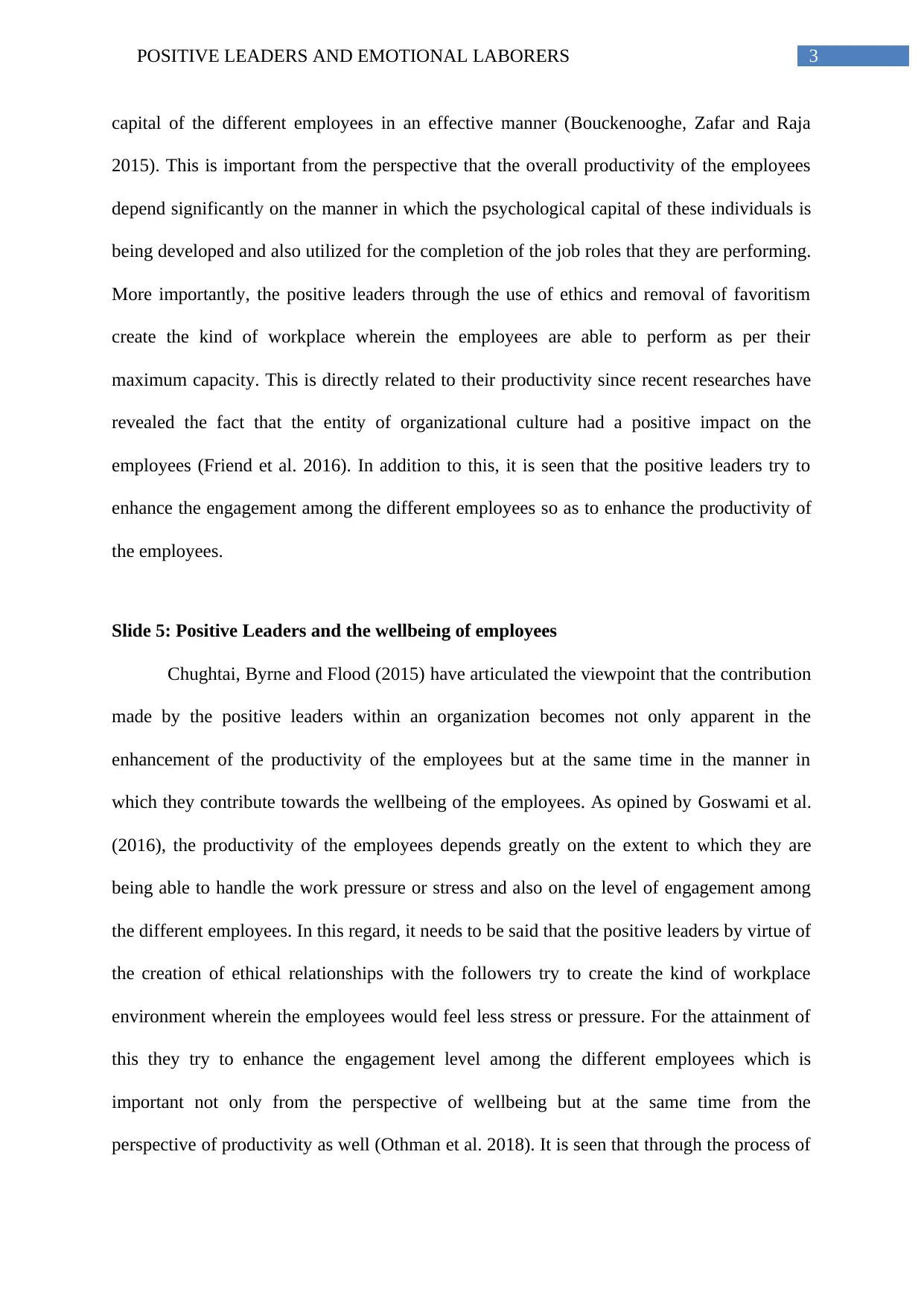
3POSITIVE LEADERS AND EMOTIONAL LABORERS
capital of the different employees in an effective manner (Bouckenooghe, Zafar and Raja
2015). This is important from the perspective that the overall productivity of the employees
depend significantly on the manner in which the psychological capital of these individuals is
being developed and also utilized for the completion of the job roles that they are performing.
More importantly, the positive leaders through the use of ethics and removal of favoritism
create the kind of workplace wherein the employees are able to perform as per their
maximum capacity. This is directly related to their productivity since recent researches have
revealed the fact that the entity of organizational culture had a positive impact on the
employees (Friend et al. 2016). In addition to this, it is seen that the positive leaders try to
enhance the engagement among the different employees so as to enhance the productivity of
the employees.
Slide 5: Positive Leaders and the wellbeing of employees
Chughtai, Byrne and Flood (2015) have articulated the viewpoint that the contribution
made by the positive leaders within an organization becomes not only apparent in the
enhancement of the productivity of the employees but at the same time in the manner in
which they contribute towards the wellbeing of the employees. As opined by Goswami et al.
(2016), the productivity of the employees depends greatly on the extent to which they are
being able to handle the work pressure or stress and also on the level of engagement among
the different employees. In this regard, it needs to be said that the positive leaders by virtue of
the creation of ethical relationships with the followers try to create the kind of workplace
environment wherein the employees would feel less stress or pressure. For the attainment of
this they try to enhance the engagement level among the different employees which is
important not only from the perspective of wellbeing but at the same time from the
perspective of productivity as well (Othman et al. 2018). It is seen that through the process of
capital of the different employees in an effective manner (Bouckenooghe, Zafar and Raja
2015). This is important from the perspective that the overall productivity of the employees
depend significantly on the manner in which the psychological capital of these individuals is
being developed and also utilized for the completion of the job roles that they are performing.
More importantly, the positive leaders through the use of ethics and removal of favoritism
create the kind of workplace wherein the employees are able to perform as per their
maximum capacity. This is directly related to their productivity since recent researches have
revealed the fact that the entity of organizational culture had a positive impact on the
employees (Friend et al. 2016). In addition to this, it is seen that the positive leaders try to
enhance the engagement among the different employees so as to enhance the productivity of
the employees.
Slide 5: Positive Leaders and the wellbeing of employees
Chughtai, Byrne and Flood (2015) have articulated the viewpoint that the contribution
made by the positive leaders within an organization becomes not only apparent in the
enhancement of the productivity of the employees but at the same time in the manner in
which they contribute towards the wellbeing of the employees. As opined by Goswami et al.
(2016), the productivity of the employees depends greatly on the extent to which they are
being able to handle the work pressure or stress and also on the level of engagement among
the different employees. In this regard, it needs to be said that the positive leaders by virtue of
the creation of ethical relationships with the followers try to create the kind of workplace
environment wherein the employees would feel less stress or pressure. For the attainment of
this they try to enhance the engagement level among the different employees which is
important not only from the perspective of wellbeing but at the same time from the
perspective of productivity as well (Othman et al. 2018). It is seen that through the process of
Secure Best Marks with AI Grader
Need help grading? Try our AI Grader for instant feedback on your assignments.
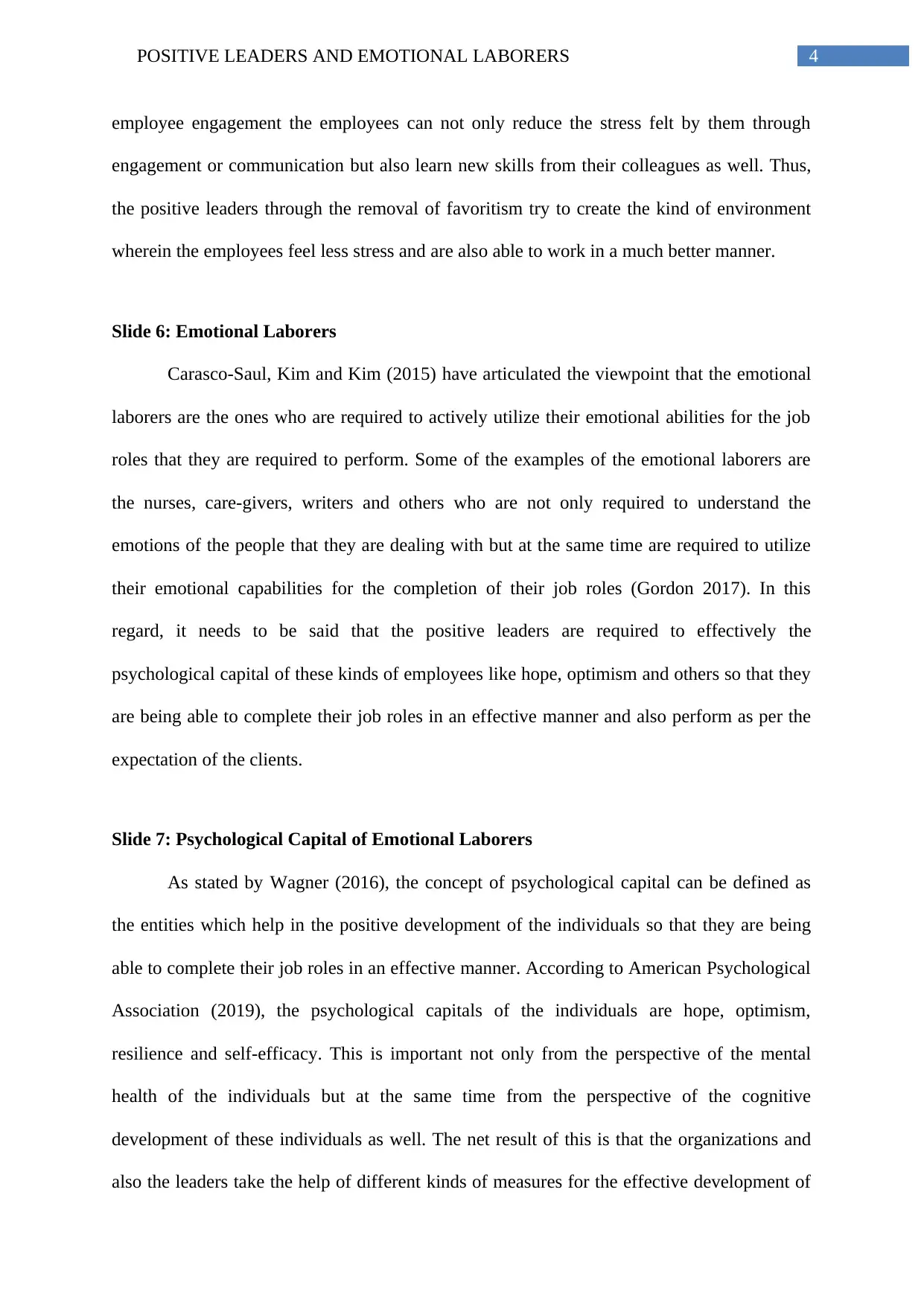
4POSITIVE LEADERS AND EMOTIONAL LABORERS
employee engagement the employees can not only reduce the stress felt by them through
engagement or communication but also learn new skills from their colleagues as well. Thus,
the positive leaders through the removal of favoritism try to create the kind of environment
wherein the employees feel less stress and are also able to work in a much better manner.
Slide 6: Emotional Laborers
Carasco-Saul, Kim and Kim (2015) have articulated the viewpoint that the emotional
laborers are the ones who are required to actively utilize their emotional abilities for the job
roles that they are required to perform. Some of the examples of the emotional laborers are
the nurses, care-givers, writers and others who are not only required to understand the
emotions of the people that they are dealing with but at the same time are required to utilize
their emotional capabilities for the completion of their job roles (Gordon 2017). In this
regard, it needs to be said that the positive leaders are required to effectively the
psychological capital of these kinds of employees like hope, optimism and others so that they
are being able to complete their job roles in an effective manner and also perform as per the
expectation of the clients.
Slide 7: Psychological Capital of Emotional Laborers
As stated by Wagner (2016), the concept of psychological capital can be defined as
the entities which help in the positive development of the individuals so that they are being
able to complete their job roles in an effective manner. According to American Psychological
Association (2019), the psychological capitals of the individuals are hope, optimism,
resilience and self-efficacy. This is important not only from the perspective of the mental
health of the individuals but at the same time from the perspective of the cognitive
development of these individuals as well. The net result of this is that the organizations and
also the leaders take the help of different kinds of measures for the effective development of
employee engagement the employees can not only reduce the stress felt by them through
engagement or communication but also learn new skills from their colleagues as well. Thus,
the positive leaders through the removal of favoritism try to create the kind of environment
wherein the employees feel less stress and are also able to work in a much better manner.
Slide 6: Emotional Laborers
Carasco-Saul, Kim and Kim (2015) have articulated the viewpoint that the emotional
laborers are the ones who are required to actively utilize their emotional abilities for the job
roles that they are required to perform. Some of the examples of the emotional laborers are
the nurses, care-givers, writers and others who are not only required to understand the
emotions of the people that they are dealing with but at the same time are required to utilize
their emotional capabilities for the completion of their job roles (Gordon 2017). In this
regard, it needs to be said that the positive leaders are required to effectively the
psychological capital of these kinds of employees like hope, optimism and others so that they
are being able to complete their job roles in an effective manner and also perform as per the
expectation of the clients.
Slide 7: Psychological Capital of Emotional Laborers
As stated by Wagner (2016), the concept of psychological capital can be defined as
the entities which help in the positive development of the individuals so that they are being
able to complete their job roles in an effective manner. According to American Psychological
Association (2019), the psychological capitals of the individuals are hope, optimism,
resilience and self-efficacy. This is important not only from the perspective of the mental
health of the individuals but at the same time from the perspective of the cognitive
development of these individuals as well. The net result of this is that the organizations and
also the leaders take the help of different kinds of measures for the effective development of
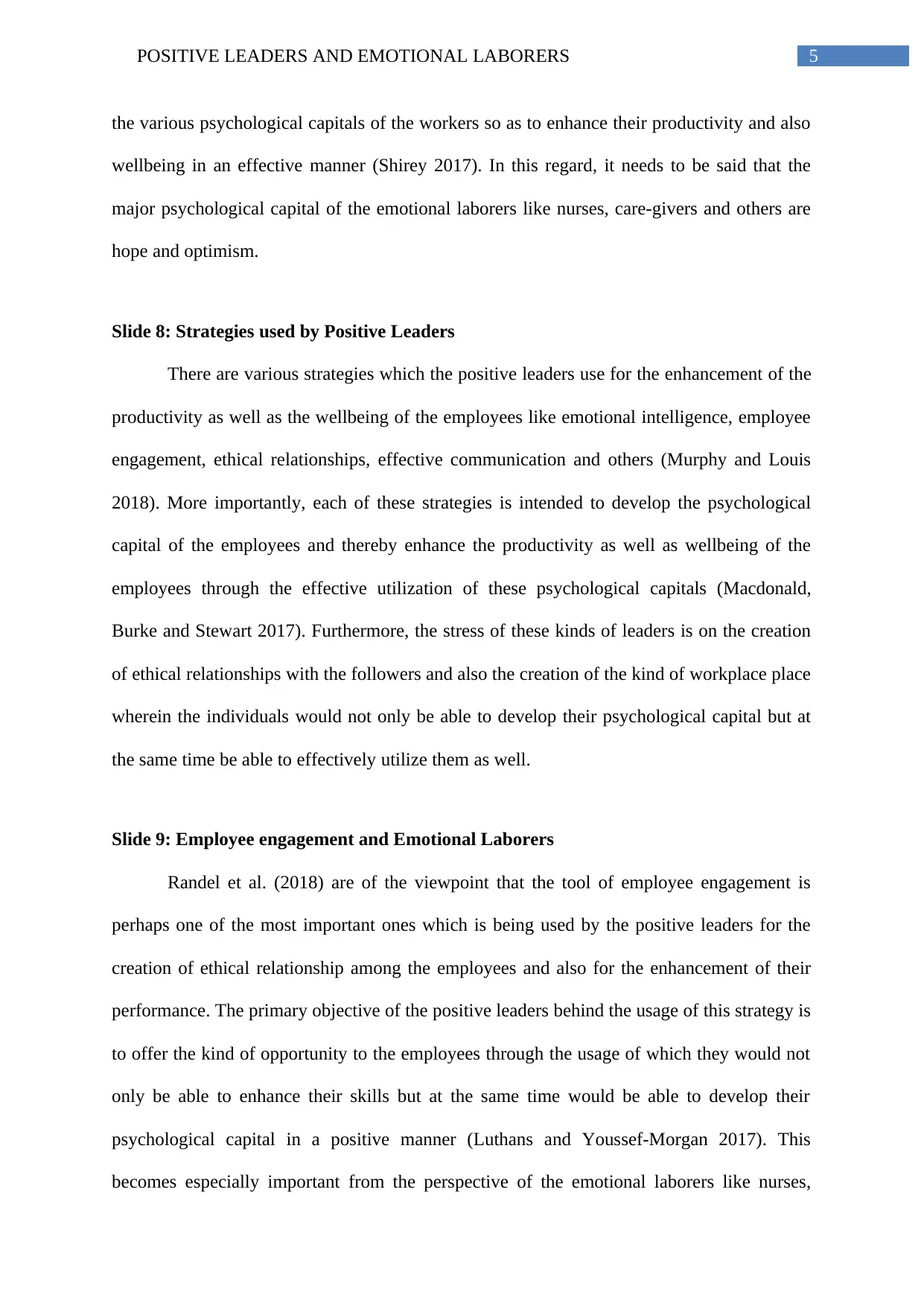
5POSITIVE LEADERS AND EMOTIONAL LABORERS
the various psychological capitals of the workers so as to enhance their productivity and also
wellbeing in an effective manner (Shirey 2017). In this regard, it needs to be said that the
major psychological capital of the emotional laborers like nurses, care-givers and others are
hope and optimism.
Slide 8: Strategies used by Positive Leaders
There are various strategies which the positive leaders use for the enhancement of the
productivity as well as the wellbeing of the employees like emotional intelligence, employee
engagement, ethical relationships, effective communication and others (Murphy and Louis
2018). More importantly, each of these strategies is intended to develop the psychological
capital of the employees and thereby enhance the productivity as well as wellbeing of the
employees through the effective utilization of these psychological capitals (Macdonald,
Burke and Stewart 2017). Furthermore, the stress of these kinds of leaders is on the creation
of ethical relationships with the followers and also the creation of the kind of workplace place
wherein the individuals would not only be able to develop their psychological capital but at
the same time be able to effectively utilize them as well.
Slide 9: Employee engagement and Emotional Laborers
Randel et al. (2018) are of the viewpoint that the tool of employee engagement is
perhaps one of the most important ones which is being used by the positive leaders for the
creation of ethical relationship among the employees and also for the enhancement of their
performance. The primary objective of the positive leaders behind the usage of this strategy is
to offer the kind of opportunity to the employees through the usage of which they would not
only be able to enhance their skills but at the same time would be able to develop their
psychological capital in a positive manner (Luthans and Youssef-Morgan 2017). This
becomes especially important from the perspective of the emotional laborers like nurses,
the various psychological capitals of the workers so as to enhance their productivity and also
wellbeing in an effective manner (Shirey 2017). In this regard, it needs to be said that the
major psychological capital of the emotional laborers like nurses, care-givers and others are
hope and optimism.
Slide 8: Strategies used by Positive Leaders
There are various strategies which the positive leaders use for the enhancement of the
productivity as well as the wellbeing of the employees like emotional intelligence, employee
engagement, ethical relationships, effective communication and others (Murphy and Louis
2018). More importantly, each of these strategies is intended to develop the psychological
capital of the employees and thereby enhance the productivity as well as wellbeing of the
employees through the effective utilization of these psychological capitals (Macdonald,
Burke and Stewart 2017). Furthermore, the stress of these kinds of leaders is on the creation
of ethical relationships with the followers and also the creation of the kind of workplace place
wherein the individuals would not only be able to develop their psychological capital but at
the same time be able to effectively utilize them as well.
Slide 9: Employee engagement and Emotional Laborers
Randel et al. (2018) are of the viewpoint that the tool of employee engagement is
perhaps one of the most important ones which is being used by the positive leaders for the
creation of ethical relationship among the employees and also for the enhancement of their
performance. The primary objective of the positive leaders behind the usage of this strategy is
to offer the kind of opportunity to the employees through the usage of which they would not
only be able to enhance their skills but at the same time would be able to develop their
psychological capital in a positive manner (Luthans and Youssef-Morgan 2017). This
becomes especially important from the perspective of the emotional laborers like nurses,
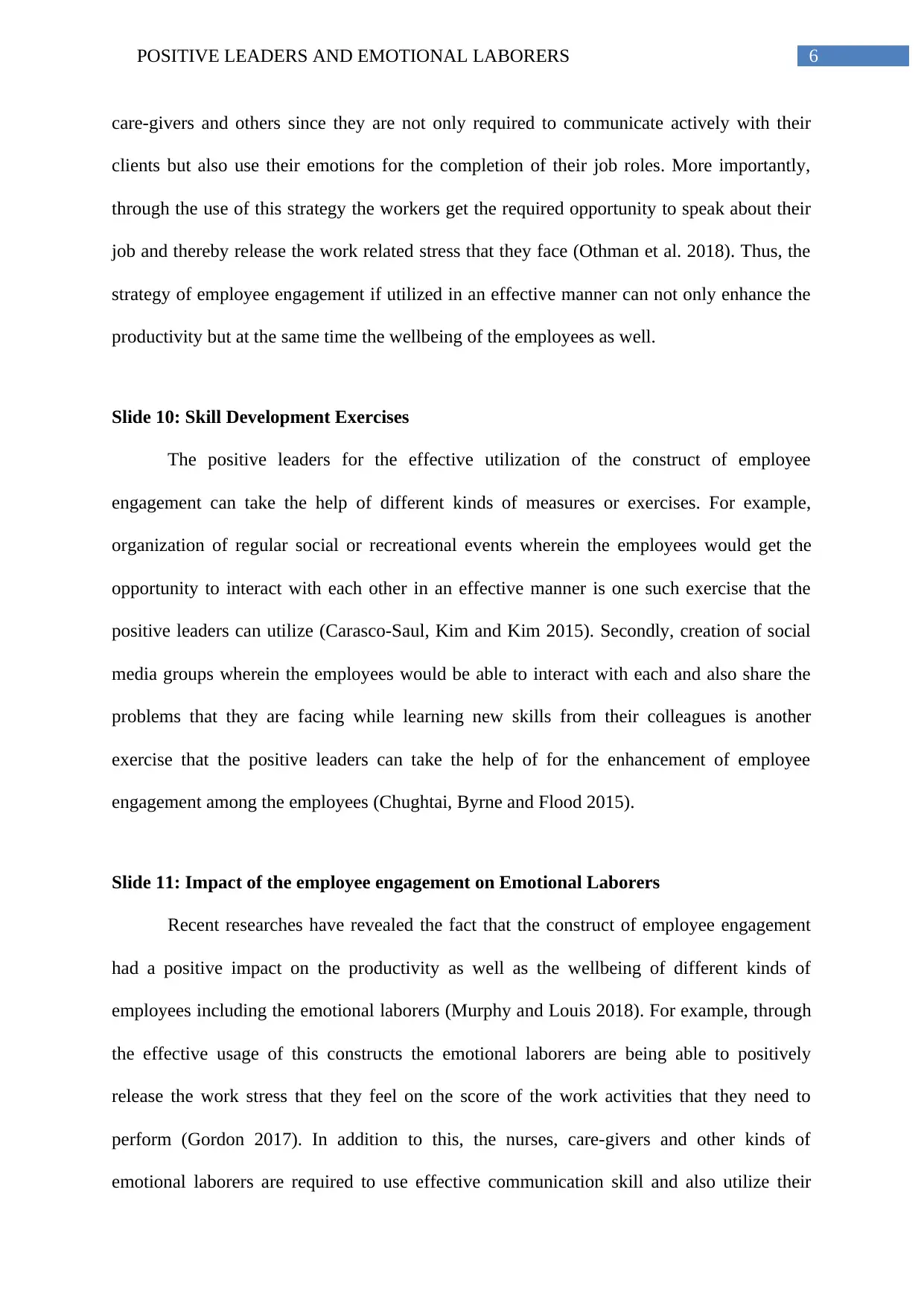
6POSITIVE LEADERS AND EMOTIONAL LABORERS
care-givers and others since they are not only required to communicate actively with their
clients but also use their emotions for the completion of their job roles. More importantly,
through the use of this strategy the workers get the required opportunity to speak about their
job and thereby release the work related stress that they face (Othman et al. 2018). Thus, the
strategy of employee engagement if utilized in an effective manner can not only enhance the
productivity but at the same time the wellbeing of the employees as well.
Slide 10: Skill Development Exercises
The positive leaders for the effective utilization of the construct of employee
engagement can take the help of different kinds of measures or exercises. For example,
organization of regular social or recreational events wherein the employees would get the
opportunity to interact with each other in an effective manner is one such exercise that the
positive leaders can utilize (Carasco-Saul, Kim and Kim 2015). Secondly, creation of social
media groups wherein the employees would be able to interact with each and also share the
problems that they are facing while learning new skills from their colleagues is another
exercise that the positive leaders can take the help of for the enhancement of employee
engagement among the employees (Chughtai, Byrne and Flood 2015).
Slide 11: Impact of the employee engagement on Emotional Laborers
Recent researches have revealed the fact that the construct of employee engagement
had a positive impact on the productivity as well as the wellbeing of different kinds of
employees including the emotional laborers (Murphy and Louis 2018). For example, through
the effective usage of this constructs the emotional laborers are being able to positively
release the work stress that they feel on the score of the work activities that they need to
perform (Gordon 2017). In addition to this, the nurses, care-givers and other kinds of
emotional laborers are required to use effective communication skill and also utilize their
care-givers and others since they are not only required to communicate actively with their
clients but also use their emotions for the completion of their job roles. More importantly,
through the use of this strategy the workers get the required opportunity to speak about their
job and thereby release the work related stress that they face (Othman et al. 2018). Thus, the
strategy of employee engagement if utilized in an effective manner can not only enhance the
productivity but at the same time the wellbeing of the employees as well.
Slide 10: Skill Development Exercises
The positive leaders for the effective utilization of the construct of employee
engagement can take the help of different kinds of measures or exercises. For example,
organization of regular social or recreational events wherein the employees would get the
opportunity to interact with each other in an effective manner is one such exercise that the
positive leaders can utilize (Carasco-Saul, Kim and Kim 2015). Secondly, creation of social
media groups wherein the employees would be able to interact with each and also share the
problems that they are facing while learning new skills from their colleagues is another
exercise that the positive leaders can take the help of for the enhancement of employee
engagement among the employees (Chughtai, Byrne and Flood 2015).
Slide 11: Impact of the employee engagement on Emotional Laborers
Recent researches have revealed the fact that the construct of employee engagement
had a positive impact on the productivity as well as the wellbeing of different kinds of
employees including the emotional laborers (Murphy and Louis 2018). For example, through
the effective usage of this constructs the emotional laborers are being able to positively
release the work stress that they feel on the score of the work activities that they need to
perform (Gordon 2017). In addition to this, the nurses, care-givers and other kinds of
emotional laborers are required to use effective communication skill and also utilize their
Paraphrase This Document
Need a fresh take? Get an instant paraphrase of this document with our AI Paraphraser
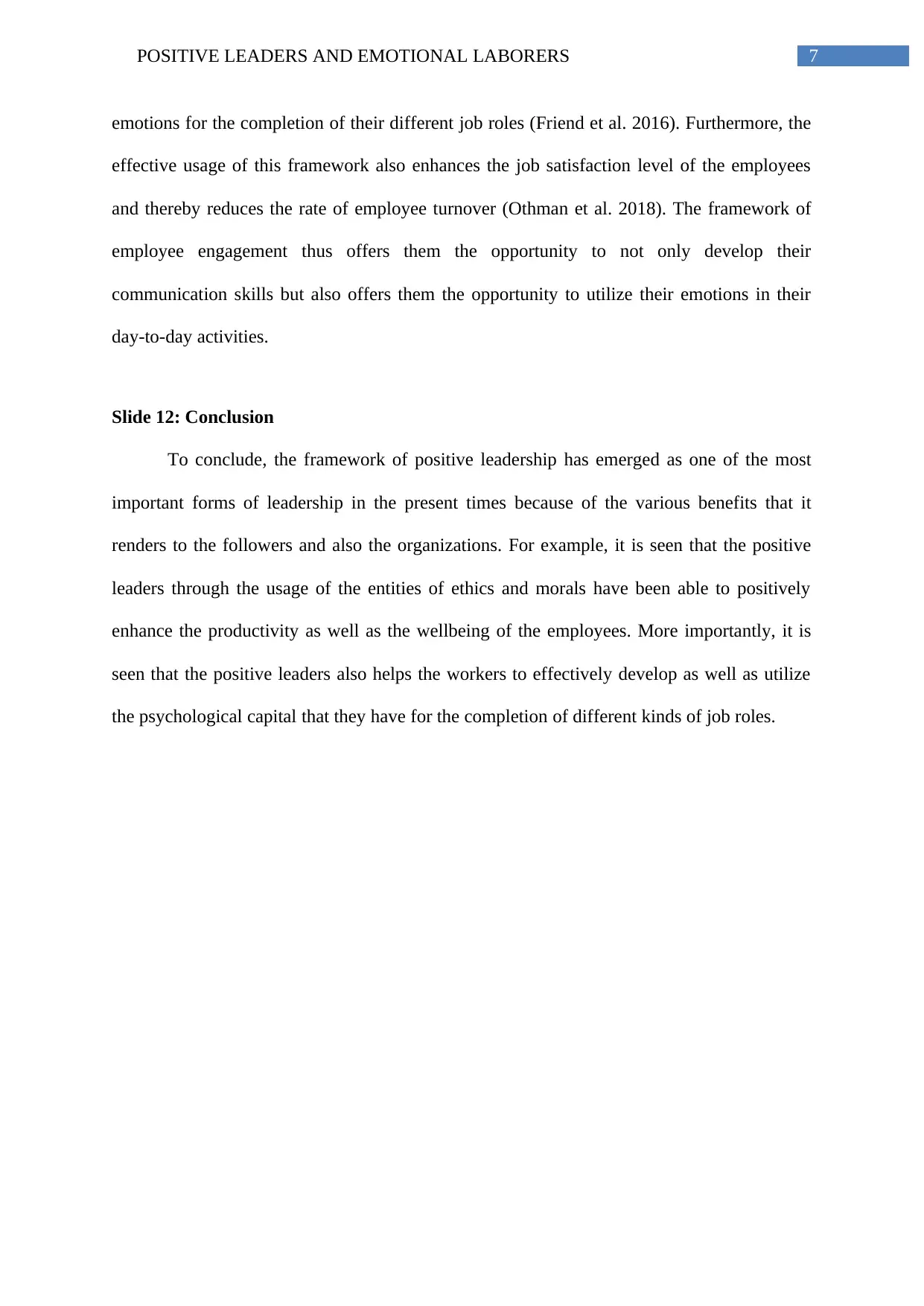
7POSITIVE LEADERS AND EMOTIONAL LABORERS
emotions for the completion of their different job roles (Friend et al. 2016). Furthermore, the
effective usage of this framework also enhances the job satisfaction level of the employees
and thereby reduces the rate of employee turnover (Othman et al. 2018). The framework of
employee engagement thus offers them the opportunity to not only develop their
communication skills but also offers them the opportunity to utilize their emotions in their
day-to-day activities.
Slide 12: Conclusion
To conclude, the framework of positive leadership has emerged as one of the most
important forms of leadership in the present times because of the various benefits that it
renders to the followers and also the organizations. For example, it is seen that the positive
leaders through the usage of the entities of ethics and morals have been able to positively
enhance the productivity as well as the wellbeing of the employees. More importantly, it is
seen that the positive leaders also helps the workers to effectively develop as well as utilize
the psychological capital that they have for the completion of different kinds of job roles.
emotions for the completion of their different job roles (Friend et al. 2016). Furthermore, the
effective usage of this framework also enhances the job satisfaction level of the employees
and thereby reduces the rate of employee turnover (Othman et al. 2018). The framework of
employee engagement thus offers them the opportunity to not only develop their
communication skills but also offers them the opportunity to utilize their emotions in their
day-to-day activities.
Slide 12: Conclusion
To conclude, the framework of positive leadership has emerged as one of the most
important forms of leadership in the present times because of the various benefits that it
renders to the followers and also the organizations. For example, it is seen that the positive
leaders through the usage of the entities of ethics and morals have been able to positively
enhance the productivity as well as the wellbeing of the employees. More importantly, it is
seen that the positive leaders also helps the workers to effectively develop as well as utilize
the psychological capital that they have for the completion of different kinds of job roles.
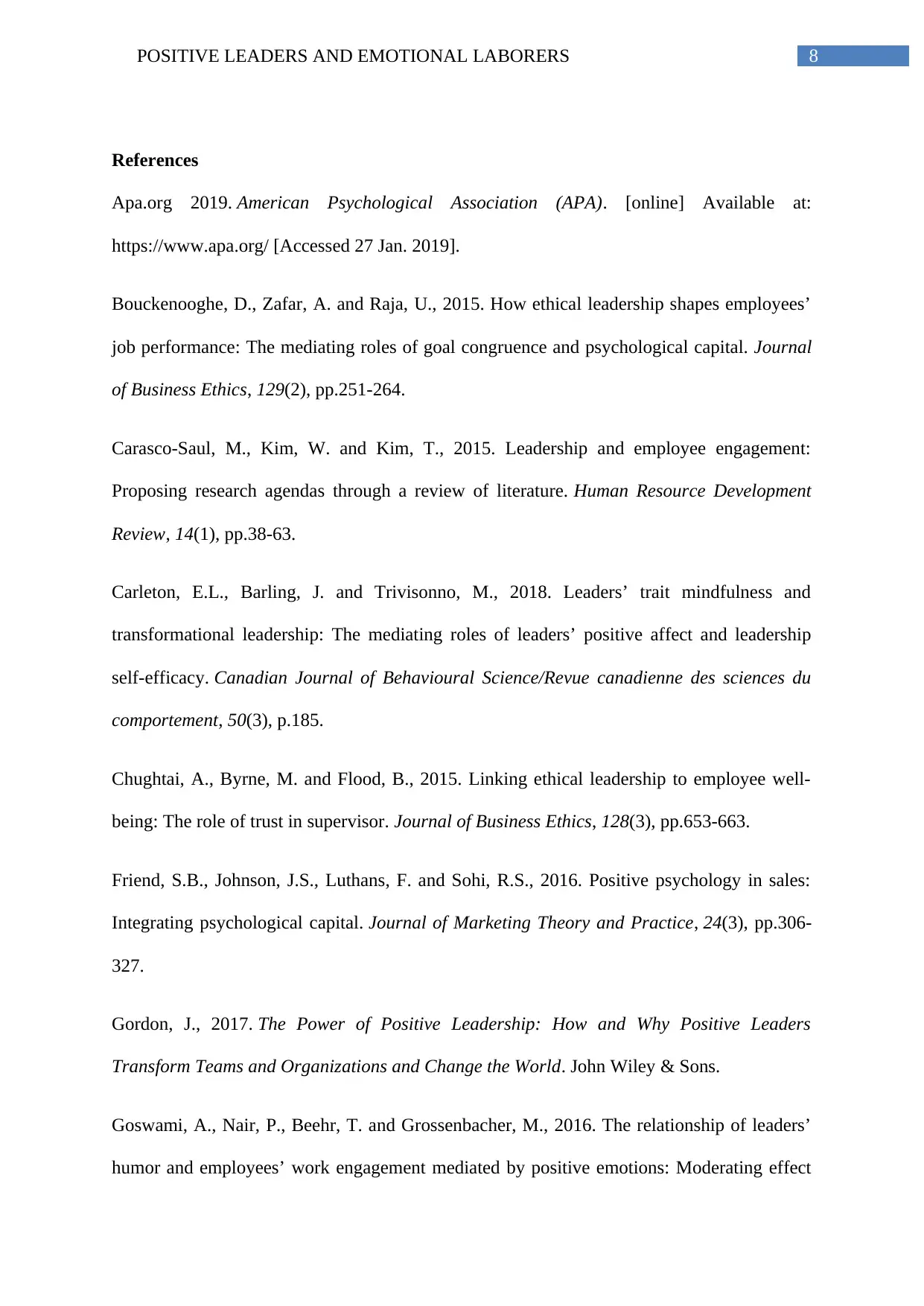
8POSITIVE LEADERS AND EMOTIONAL LABORERS
References
Apa.org 2019. American Psychological Association (APA). [online] Available at:
https://www.apa.org/ [Accessed 27 Jan. 2019].
Bouckenooghe, D., Zafar, A. and Raja, U., 2015. How ethical leadership shapes employees’
job performance: The mediating roles of goal congruence and psychological capital. Journal
of Business Ethics, 129(2), pp.251-264.
Carasco-Saul, M., Kim, W. and Kim, T., 2015. Leadership and employee engagement:
Proposing research agendas through a review of literature. Human Resource Development
Review, 14(1), pp.38-63.
Carleton, E.L., Barling, J. and Trivisonno, M., 2018. Leaders’ trait mindfulness and
transformational leadership: The mediating roles of leaders’ positive affect and leadership
self-efficacy. Canadian Journal of Behavioural Science/Revue canadienne des sciences du
comportement, 50(3), p.185.
Chughtai, A., Byrne, M. and Flood, B., 2015. Linking ethical leadership to employee well-
being: The role of trust in supervisor. Journal of Business Ethics, 128(3), pp.653-663.
Friend, S.B., Johnson, J.S., Luthans, F. and Sohi, R.S., 2016. Positive psychology in sales:
Integrating psychological capital. Journal of Marketing Theory and Practice, 24(3), pp.306-
327.
Gordon, J., 2017. The Power of Positive Leadership: How and Why Positive Leaders
Transform Teams and Organizations and Change the World. John Wiley & Sons.
Goswami, A., Nair, P., Beehr, T. and Grossenbacher, M., 2016. The relationship of leaders’
humor and employees’ work engagement mediated by positive emotions: Moderating effect
References
Apa.org 2019. American Psychological Association (APA). [online] Available at:
https://www.apa.org/ [Accessed 27 Jan. 2019].
Bouckenooghe, D., Zafar, A. and Raja, U., 2015. How ethical leadership shapes employees’
job performance: The mediating roles of goal congruence and psychological capital. Journal
of Business Ethics, 129(2), pp.251-264.
Carasco-Saul, M., Kim, W. and Kim, T., 2015. Leadership and employee engagement:
Proposing research agendas through a review of literature. Human Resource Development
Review, 14(1), pp.38-63.
Carleton, E.L., Barling, J. and Trivisonno, M., 2018. Leaders’ trait mindfulness and
transformational leadership: The mediating roles of leaders’ positive affect and leadership
self-efficacy. Canadian Journal of Behavioural Science/Revue canadienne des sciences du
comportement, 50(3), p.185.
Chughtai, A., Byrne, M. and Flood, B., 2015. Linking ethical leadership to employee well-
being: The role of trust in supervisor. Journal of Business Ethics, 128(3), pp.653-663.
Friend, S.B., Johnson, J.S., Luthans, F. and Sohi, R.S., 2016. Positive psychology in sales:
Integrating psychological capital. Journal of Marketing Theory and Practice, 24(3), pp.306-
327.
Gordon, J., 2017. The Power of Positive Leadership: How and Why Positive Leaders
Transform Teams and Organizations and Change the World. John Wiley & Sons.
Goswami, A., Nair, P., Beehr, T. and Grossenbacher, M., 2016. The relationship of leaders’
humor and employees’ work engagement mediated by positive emotions: Moderating effect
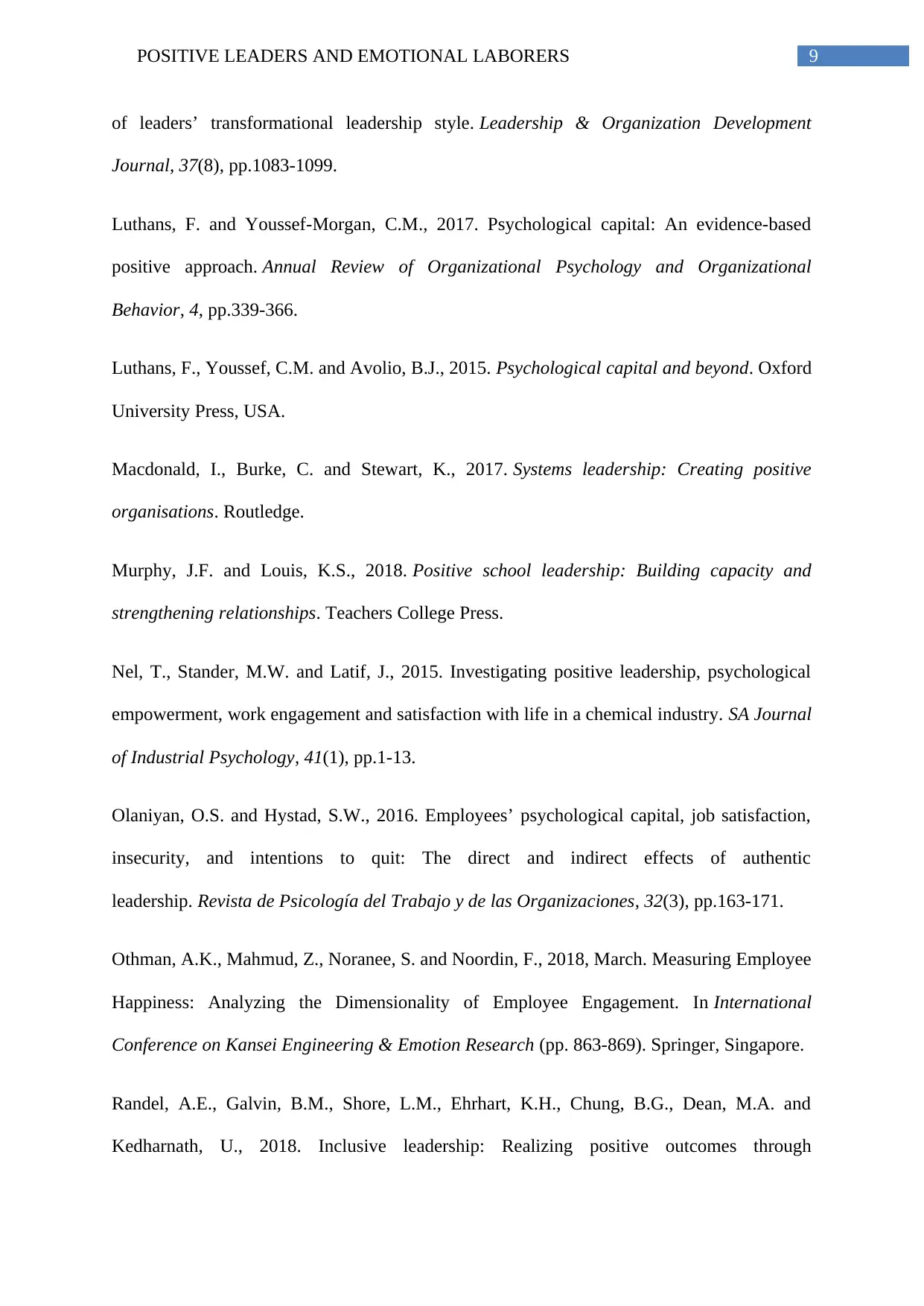
9POSITIVE LEADERS AND EMOTIONAL LABORERS
of leaders’ transformational leadership style. Leadership & Organization Development
Journal, 37(8), pp.1083-1099.
Luthans, F. and Youssef-Morgan, C.M., 2017. Psychological capital: An evidence-based
positive approach. Annual Review of Organizational Psychology and Organizational
Behavior, 4, pp.339-366.
Luthans, F., Youssef, C.M. and Avolio, B.J., 2015. Psychological capital and beyond. Oxford
University Press, USA.
Macdonald, I., Burke, C. and Stewart, K., 2017. Systems leadership: Creating positive
organisations. Routledge.
Murphy, J.F. and Louis, K.S., 2018. Positive school leadership: Building capacity and
strengthening relationships. Teachers College Press.
Nel, T., Stander, M.W. and Latif, J., 2015. Investigating positive leadership, psychological
empowerment, work engagement and satisfaction with life in a chemical industry. SA Journal
of Industrial Psychology, 41(1), pp.1-13.
Olaniyan, O.S. and Hystad, S.W., 2016. Employees’ psychological capital, job satisfaction,
insecurity, and intentions to quit: The direct and indirect effects of authentic
leadership. Revista de Psicología del Trabajo y de las Organizaciones, 32(3), pp.163-171.
Othman, A.K., Mahmud, Z., Noranee, S. and Noordin, F., 2018, March. Measuring Employee
Happiness: Analyzing the Dimensionality of Employee Engagement. In International
Conference on Kansei Engineering & Emotion Research (pp. 863-869). Springer, Singapore.
Randel, A.E., Galvin, B.M., Shore, L.M., Ehrhart, K.H., Chung, B.G., Dean, M.A. and
Kedharnath, U., 2018. Inclusive leadership: Realizing positive outcomes through
of leaders’ transformational leadership style. Leadership & Organization Development
Journal, 37(8), pp.1083-1099.
Luthans, F. and Youssef-Morgan, C.M., 2017. Psychological capital: An evidence-based
positive approach. Annual Review of Organizational Psychology and Organizational
Behavior, 4, pp.339-366.
Luthans, F., Youssef, C.M. and Avolio, B.J., 2015. Psychological capital and beyond. Oxford
University Press, USA.
Macdonald, I., Burke, C. and Stewart, K., 2017. Systems leadership: Creating positive
organisations. Routledge.
Murphy, J.F. and Louis, K.S., 2018. Positive school leadership: Building capacity and
strengthening relationships. Teachers College Press.
Nel, T., Stander, M.W. and Latif, J., 2015. Investigating positive leadership, psychological
empowerment, work engagement and satisfaction with life in a chemical industry. SA Journal
of Industrial Psychology, 41(1), pp.1-13.
Olaniyan, O.S. and Hystad, S.W., 2016. Employees’ psychological capital, job satisfaction,
insecurity, and intentions to quit: The direct and indirect effects of authentic
leadership. Revista de Psicología del Trabajo y de las Organizaciones, 32(3), pp.163-171.
Othman, A.K., Mahmud, Z., Noranee, S. and Noordin, F., 2018, March. Measuring Employee
Happiness: Analyzing the Dimensionality of Employee Engagement. In International
Conference on Kansei Engineering & Emotion Research (pp. 863-869). Springer, Singapore.
Randel, A.E., Galvin, B.M., Shore, L.M., Ehrhart, K.H., Chung, B.G., Dean, M.A. and
Kedharnath, U., 2018. Inclusive leadership: Realizing positive outcomes through
Secure Best Marks with AI Grader
Need help grading? Try our AI Grader for instant feedback on your assignments.
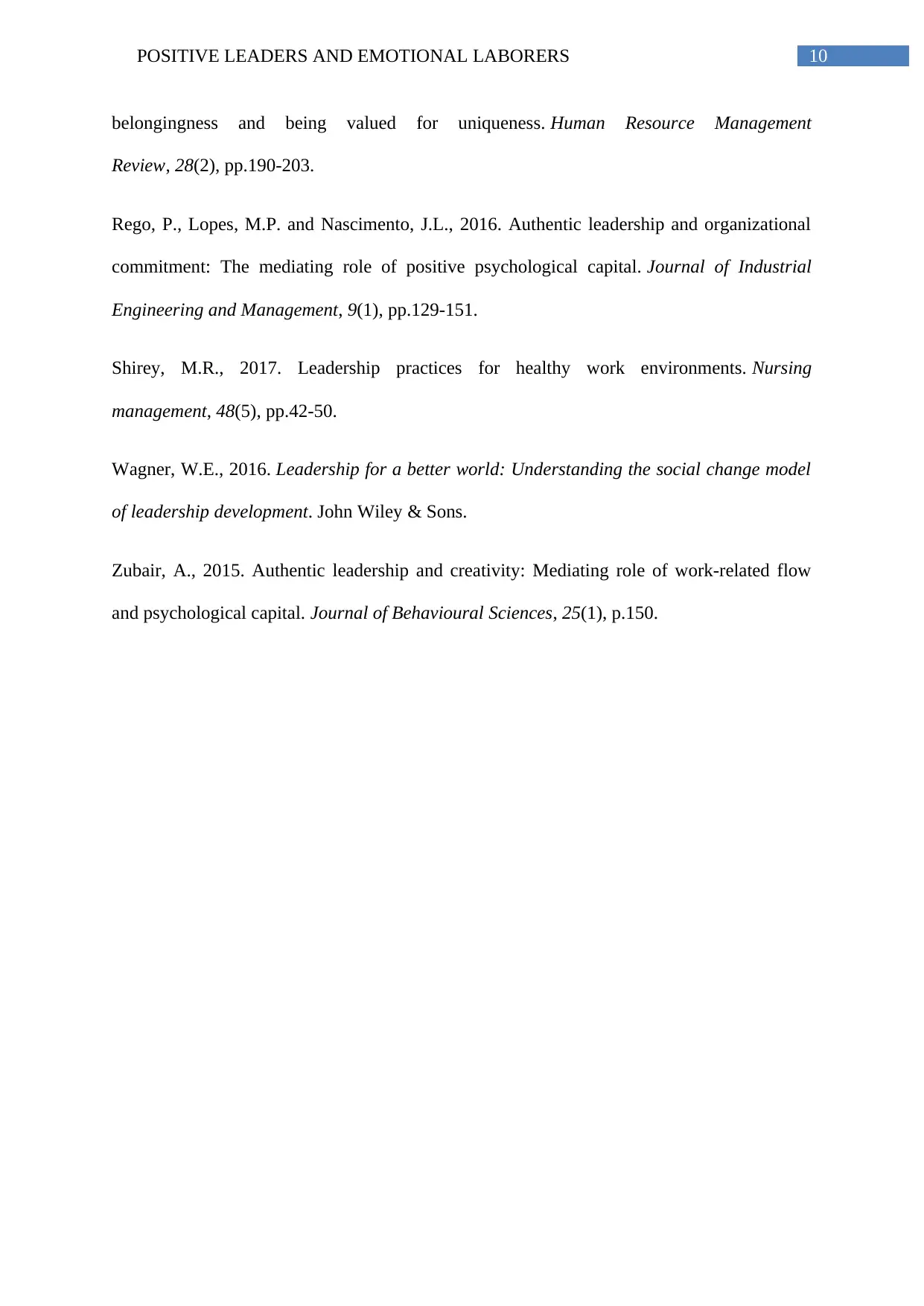
10POSITIVE LEADERS AND EMOTIONAL LABORERS
belongingness and being valued for uniqueness. Human Resource Management
Review, 28(2), pp.190-203.
Rego, P., Lopes, M.P. and Nascimento, J.L., 2016. Authentic leadership and organizational
commitment: The mediating role of positive psychological capital. Journal of Industrial
Engineering and Management, 9(1), pp.129-151.
Shirey, M.R., 2017. Leadership practices for healthy work environments. Nursing
management, 48(5), pp.42-50.
Wagner, W.E., 2016. Leadership for a better world: Understanding the social change model
of leadership development. John Wiley & Sons.
Zubair, A., 2015. Authentic leadership and creativity: Mediating role of work-related flow
and psychological capital. Journal of Behavioural Sciences, 25(1), p.150.
belongingness and being valued for uniqueness. Human Resource Management
Review, 28(2), pp.190-203.
Rego, P., Lopes, M.P. and Nascimento, J.L., 2016. Authentic leadership and organizational
commitment: The mediating role of positive psychological capital. Journal of Industrial
Engineering and Management, 9(1), pp.129-151.
Shirey, M.R., 2017. Leadership practices for healthy work environments. Nursing
management, 48(5), pp.42-50.
Wagner, W.E., 2016. Leadership for a better world: Understanding the social change model
of leadership development. John Wiley & Sons.
Zubair, A., 2015. Authentic leadership and creativity: Mediating role of work-related flow
and psychological capital. Journal of Behavioural Sciences, 25(1), p.150.
1 out of 11
Related Documents
Your All-in-One AI-Powered Toolkit for Academic Success.
+13062052269
info@desklib.com
Available 24*7 on WhatsApp / Email
![[object Object]](/_next/static/media/star-bottom.7253800d.svg)
Unlock your academic potential
© 2024 | Zucol Services PVT LTD | All rights reserved.





